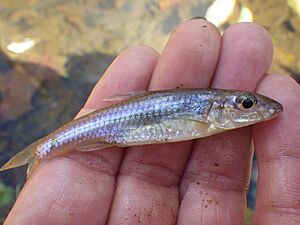Silverjaw minnow facts for kids
Quick facts for kids Silverjaw minnow |
|
|---|---|
 |
|
| In Goose Creek, Virginia (Potomac Drainage) | |
| Conservation status | |
| Scientific classification | |
| Synonyms | |
|
Ericymba buccata Cope, 1865 |
Silverjaw minnows (Notropis buccata) are small fish. They belong to the Cyprinidae family, which includes carps and other minnows. North America has over 300 types of minnows. This makes them the most common fish in freshwater there!
Minnows can look very similar, making them tricky to tell apart. All minnows have one dorsal fin (on their back). They also have fins near their tail and smooth, round scales. Most minnows have a lateral line system. This helps them sense things in the water. Minnows do not have teeth in their jaws. Instead, they have special teeth in their throat, called pharyngeal teeth, to grind food. Scientists tell different minnow types apart by looking at their fins, scales, and throat teeth.
Silverjaw minnows have a flat head underneath. They have big, shiny, silvery-white areas on their sides. These areas are part of their lateral line system. These fish are quite small, usually 2 to 3 inches long. Because they are small, many can live together in one spot. They can still find enough food and space. Silverjaw minnows live in many streams and rivers across the United States. They are found in separate areas, which is called a disjunct distribution.
Contents
What Do Silverjaw Minnows Look Like?
The silverjaw minnow has a special lateral line system. It has many shiny, silvery-white pores. These pores connect to an inner canal. This system helps the fish find prey. All minnows have fewer than ten supporting structures in their dorsal fin. These structures are called rays. Silverjaw minnows have eight soft rays. These rays are thin and flexible. Their dorsal fin is located above their pelvic region. This is where their belly fins are found.
These fish are light tan. They have a dark line along their back. Their scales have dark outlines. Silverjaw minnows also have scales on their chest. This helps tell them apart from the longjaw minnow. They do not have teeth in their jaws. But they do have pharyngeal teeth in their throat. Their eyes are almost on top of their heads, pointing upwards. Their body is a bit flat on the sides. The deepest part of their body is near their neck. They have a long snout that sticks out a little past their mouth. This helps them find food on the bottom of the water. Silverjaw minnows grow to be about 2 to 3 inches long.
Where Do Silverjaw Minnows Live?
Silverjaw minnows live in two main areas in the United States. This is called a disjunct distribution. The northern area stretches from eastern Missouri to Maryland. It goes north into the southern Great Lakes. It also goes south to the Cumberland River Drainage in northern Tennessee. They are often found in the Chesapeake Bay, Ohio River, Mississippi River, and rivers along the Atlantic Coast.
The southern area includes parts of Mississippi, Louisiana, Alabama, and Georgia. Important places they live in this area include the Apalachicola River and Pearl River drainage.
What Kind of Home Do They Like?
Silverjaw minnows live in large groups, called schools. They stay near the bottom of shallow, freshwater creeks, streams, and small to medium-sized rivers. They like places with gravelly or sandy floors. They prefer fast-moving water, like in riffles. They usually live in clear water that does not have much silt.
What Do Silverjaw Minnows Eat?
The silverjaw minnow is a bottom-feeder. This means it eats food found on the riverbed. They mostly eat during the day. Their food includes small insects like chironomids (non-biting midges), ephemeroptera (mayflies), and cladocera (water fleas). They also hunt at night if there is not much food during the day.
They have four main ways of finding food: searching, mouthing, jabbing, and digging. All these ways involve looking for food on the bottom. The amount of food available and what other fish in the school are doing can affect how they feed. Silverjaw minnows are picky eaters. They only eat less than half of the organisms they find on the bottom. They use their sense of taste and touch to decide what to eat.
Reproduction and Life Cycle
Silverjaw minnows usually live for three to four years. Their eggs hatch between late spring and late summer. Fish grow during their second and third summers. This growth happens from May or June until the end of July. They stop growing during the fall and winter. This is because their metabolic rate slows down.
They become ready to have babies late in their first summer or in their second summer. Adult minnows usually spawn (lay eggs) in mid-spring. However, young fish from the previous year might spawn in July. The eggs are scattered on the bottom of the riverbed.
Why Are Silverjaw Minnows Important?
Minnows are important for the fishing industry. They are often used as bait by people who fish. Minnows are also a key food source for bigger fish. These larger fish are often caught by fishermen for sport or food.
What's in a Name?
The silverjaw minnow gets its name from the shiny, silver-looking sensory organs on its jaw. The word minnow comes from an old Anglo-Saxon word, myne, which means "small." The scientific name, Ericymba buccata, also has a meaning. Eri is a Greek word meaning "intensifying." Cymba is a Greek word meaning "cavity." And buccata is a Latin word meaning "cheek."



